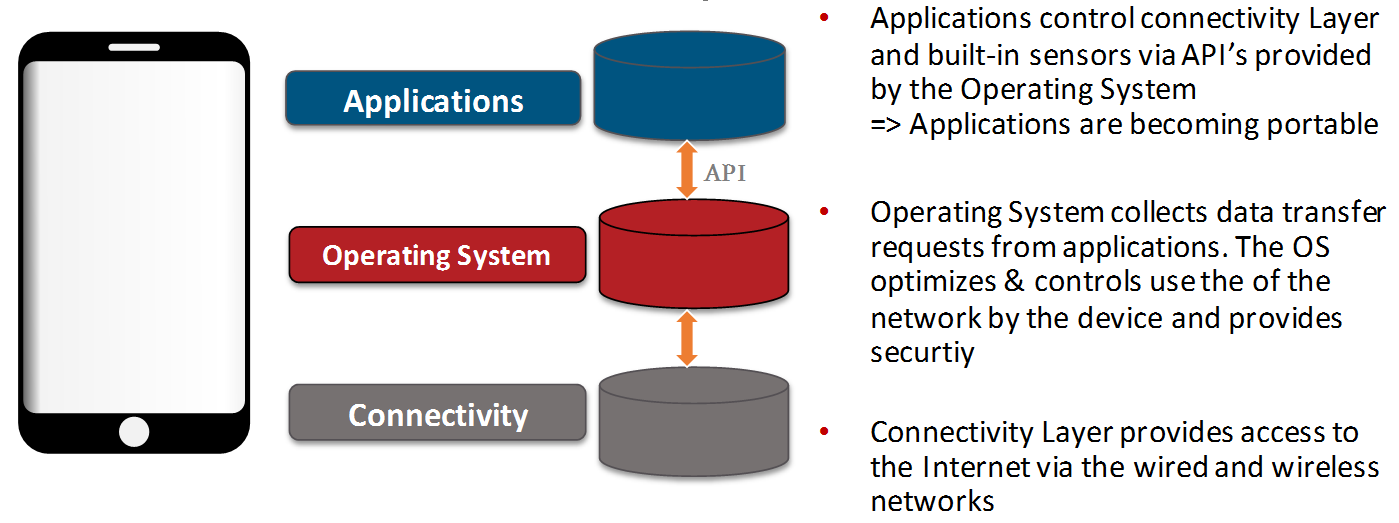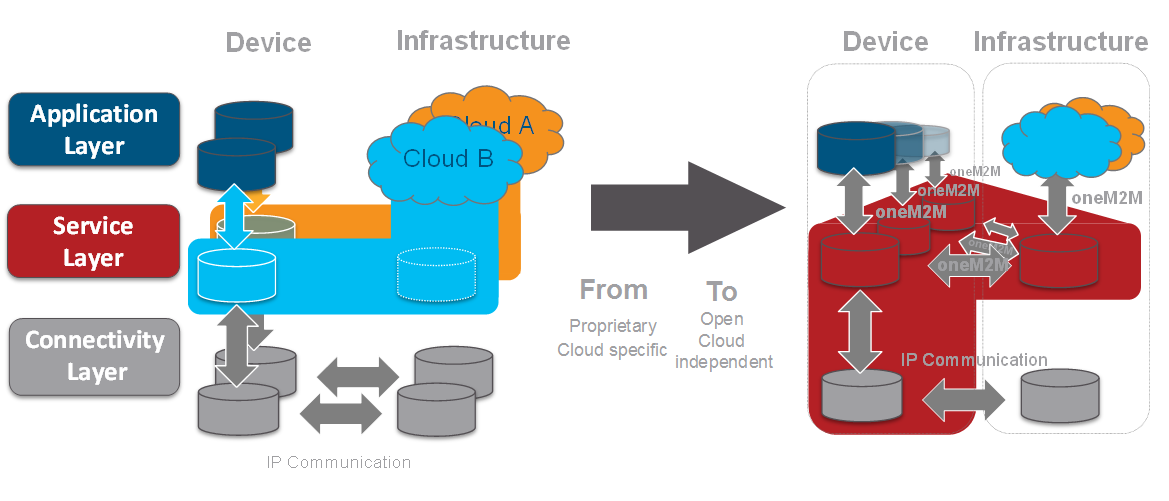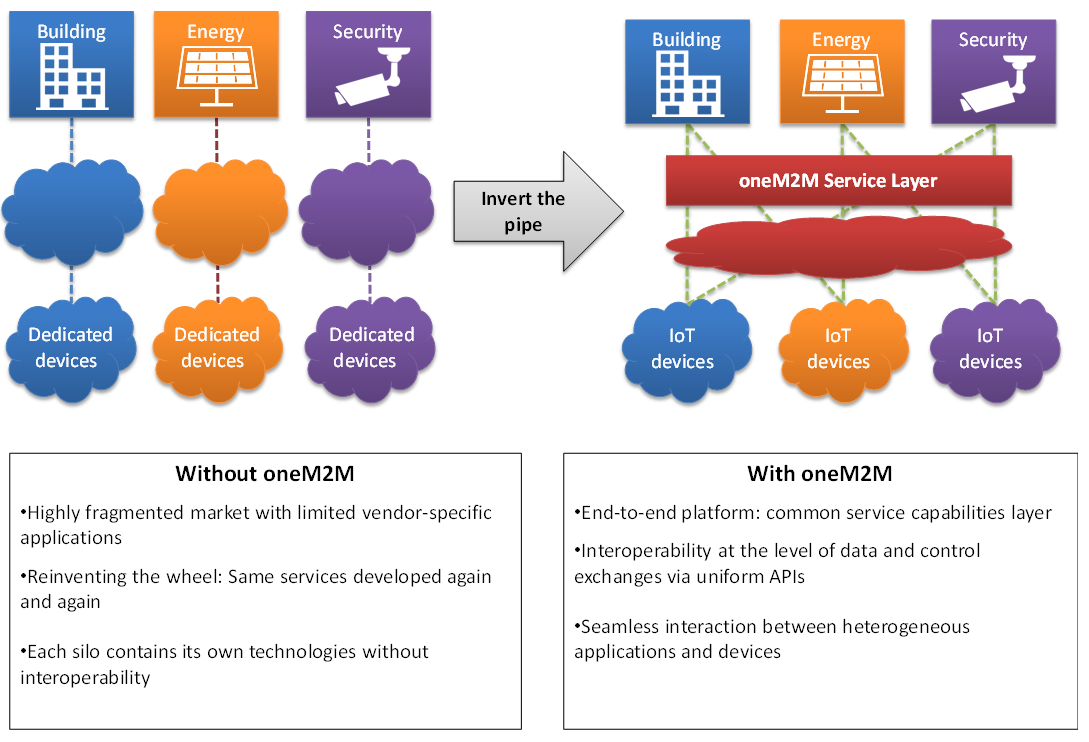News
Template:Lowercase title Template:Infobox company
oneM2M is a global organization that creates requirements, architecture, API specifications, security solutions and interoperability for Machine-to-Machine and IoT technologies.<ref>Template:Cite web</ref>
oneM2M specifications provide a framework to support a wide range of applications and services such as smart cities, smart grid, connected car, home automation, public safety, and health.<ref>Template:Cite web</ref><ref>Template:Cite web</ref>
Overview
oneM2M Service Layer for multivendor interoperability
The architecture standardized by oneM2M defines an IoT Service Layer, i.e. a vendor independent software Middleware sitting between processing / communication hardware and IoT applications providing a set of functions commonly needed by IoT applications.
The oneM2M Service Layer provides use case independent functions.
- oneM2M Common Service layer Functions (CSF’s) provide proper:
- Identification of users and applications
- authentication & authorization of users and applications
- end-to-end data encryption
- remote provisioning & service activation
- device management,
- connectivity setup & data transmission scheduling,
- data aggregation, buffering in case of missing connectivity and synchronization upon connectivity re-establishment
- group management and application and data discovery functions
- etc ...
The functions listed above provided by the oneM2M common service layer, are exposed and controlled via globally standardized vendor independent and uniform APIs, towards the IoT applications.
IoT applications or more generically “Application Entities” AE’s are generic terms for applications executed in so called Application Dedicated Nodes ADNs or Middle Nodes MNs and at the Infrastructure Node IN.
Applications (AEs) at the device (ADN, MN) and the Infrastructure Platform (IN) are separated by the oneM2M APIs from the actual oneM2M Common Service functions (CSFs) like the ones listed above.
Details and specifics of the underlying- connectivity technologies, transport protocols and data serialization formats are not exposed to the application developer. This avoids the necessity of detailed expertise in used connectivity technologies, and hence allows the application developer to focus on the customer actual IoT application.
Interactions between oneM2M Common Service functions (CSFs) and the application are solely based on the oneM2M globally standardized, vendor independent, uniform APIs towards the applications.
For an application developer, oneM2M based technology appears like an operating system, which takes over common basic functions in context of connectivity and hardware as listed above. Hence the IoT Service Layer specified by oneM2M can be seen in a similar way as a mobile operating systems within the smart phone eco system.
Due to this separation, application developers can focus on the developing the actual IoT application for the Device e.g focusing on:
- Measuring physical parameters, preprocessing of data, controlling attached hardware or Interworking with other technologies (Modbus, CAN-Bus, OPC-UA gateways etc.)
On the infrastructure (Platform) the separation by APIs between oneM2M Common Service functions (CSFs) and application, enables a separation between “low level” tasks in context of connectivity over wide area networks (Device Management, scheduling of data transmission, enrolment of security functions and credentials, revocation of faulty device applications), and actual cloud and IoT application Platform like:
- Data analytics, Rule engines, presentation of data, User interfaces etc.
Compared to IoT devices being connected to IoT Platforms without oneM2M, the separation between Applications and oneM2M Common Service functions (CSFs), enables the possibility to become independent form the actual cloud respectively IoT Application Platform provider, since from the viewpoint of the oneM2M Common Service functions (CSFs) the actual cloud respectively IoT application Platform is regarded as an Application (AE).
Beneficially the oneM2M Common Service functions (CSFs) will become part of the communication chipset, to achieve a coverage in a wide range of devices.
oneM2M Service Layer for cross vertical interoperability
The cross vertical interoperability challenge:
- Before an application executed in car (Automotive) or on a smartphone app is able to open a (Home Domain) garage door (e.g. once a car owner appears at home), both applications need to be properly authenticated and authorized. Moreover both application need to have a common understanding about their specific data models.
- Furthermore if data generated by IoT devices are distributed and uploaded to various different IoT platforms, data are locked in or just accessible within their proprietary IoT platforms. Hence cross vertical use cases are hampered.
In to overcome these aspects oneM2M provides data models based on the so called Smart Device Template which is continuously extended with new functionalities and elements. Basic elements can be modular composed to cover a wide range of devices with various capabilities.
Due to a common understanding of the data being transferred, stored and exposed by the oneM2M Common Service layer via globally standardized, vendor independent, uniform APIs, applications are able to interwork across any vertical.
In order to control access to data generated by IoT devices, oneM2M provides Access Control Policies ACPs, controlling which applications AEs are allowed to access which parts of the data in the oneM2M Common Service layer.
Functional Architecture
oneM2M Layered Model comprises three layers:
- the Application Layer,
- the Common Services Layer
- the underlying Network Services Layer.
History
oneM2M was formed in July 2012<ref name="kt" /> and consists of eight of the world's preeminent standards development organizations (SDOs), notably: ARIB (Japan), ATIS (United States), CCSA (China), ETSI (Europe), TIA (USA), TSDSI (India), TTA (Korea) and TTC (Japan).<ref>Template:Cite web</ref> together with six industry fora, consortia or standards bodies (Broadband Forum, CEN, CENELEC, GlobalPlatform, Next Generation M2M Consortium, OMA).
oneM2M began some of the earliest work on standardization of a common platform for internet of things (IoT) systems<ref>Template:Cite web</ref>. In 2018, S. Korea's TTA reported its cooperative efforts with the ITU to bridge standardization gaps by transposing the oneM2M standard to an ITU standard<ref>Template:Cite web</ref>.
Partners
oneM2M currently have more than 200 participating partners and members consisting of Alcatel-Lucent, AT&T, BT Group, Adobe, Ericsson, Deutsche Telekom, IBM, Cisco, Sierra Wireless, InterDigital, Intel, Samsung,<ref>Template:Cite web</ref> LG Uplus and Telefonica.<ref name="kt">Template:Cite web</ref><ref>Template:Cite web</ref>
Regional Developments
South Korea is one of the leading markets for solutions based on the oneM2M standard. South Korea’s national IoT Master Plan makes explicit reference to oneM2M as a strategic enabler for IoT applications and companies developing IoT solutions.<ref>Template:Cite web.</ref> The city of Busan is implementing an open platform based on oneM2M to support a smart-city eco-system of industry-university associations.<ref>Template:Cite web</ref>
In Europe, HP Enterprise has reported commercial success in the enterprise and smart cities sectors.<ref>Template:Cite web</ref><ref>Template:Cite web</ref>
Within the UK, a public-private partnership is using InterDigital's a oneM2MTM standards-based IoT platform developed by InterDigital to support a large-scale, intelligent transport systems trial. The trial, oneTRANSPORT, is part funded by InnovateUK and involves 11 public and private sector organizations with an operational footprint that covers four contiguous counties in England (Buckinghamshire, Hertfordshire, Northamptonshire and Oxfordshire).<ref>Template:Cite web</ref> The aim of the trial is to demonstrate several journey planning, transport-event and incident management applications.
Developer Resources
The oneM2M Partnership Project maintains a WiKi for developers to learn about the oneM2M community, software releases and collaborative development processes.<ref>Template:Cite web.</ref>
References
1. ^ Blewitt, Alex. "Eclipse Foundation Releases IoT Projects". InfoQ. Retrieved 25 August 2016. 2. ^ Frenzel, Lou. "Wireless Is Headed…Where?". Electronic Design magazine. Retrieved 25 August 2016. 3. ^ Briodagh, Ken. "oneM2M to Release Next Standards in Autumn to Expand IoT Interconnectivity". IoT Evolution World. Retrieved 25 August 2016. 4. ^ Carlton, Alan. "IoT is not about radios; it's all about data". Network World. Retrieved 15 September 2016. 5. ^ Gopalakrishnan, Arvind. "oneM2M implications on IOT platforms for enterprises". Dataquest. Retrieved 25 August 2016. 6. ^ Abbas, Muntazir. "C-DoT builds first open machine-to-machine platform". The Economic Times. Retrieved 25 August 2016. 7. ^ a b Yoo-chul, Kim (15 July 2016). "LG Uplus expands international business". The Korea Times. Retrieved 25 August 2016. 8. ^ "oneM2M welcomes GlobalPlatform, TSDSI as partners". Telecompaper. Retrieved 25 August 2016. 9. ^ "Industrial Internet Consortium - Business Strategy & Innovation Framework - Figure 6-3: Timeline of Standardization Efforts" (PDF). www.iiconsortium.org. Archived from the original (PDF) on 2016. Retrieved 2018-12-13. 10. ^ "TTA-ITU cooperative BSG (bridging the standardization gap) project". www.tta.or.kr. Retrieved 2018-12-13. 11. ^ Maddox, Teena. "Can Samsung's $1.2 billion investment launch the era of 'human-centered' IoT?". TechRepublic. Retrieved 25 August 2016. 12. ^ Babcock, Charles. "HPE Offers IoT Platform To Build, Analyze Data". InformationWeek. Retrieved 25 August 2016. 13. ^ Waring, Joseph (10 June 2015). "SK Telecom unveils open IoT platform based on oneM2M". Mobile World Live. Retrieved 25 August 2016.. 14. ^ "Busan - Global Smart City". Busan - Global Smart City. Retrieved 10 October 2016. 15. ^ "HPE's IoT Platform Supports oneM2M, LoRa, SigFox". Linux.com. Retrieved 2016-06-19. 16. ^ Preimesberger, Chris. "HPE Moves Into IoT Management With All-Purpose Platform". eWeek. Retrieved 25 August 2016. 17. ^ "oneTRANSPORT Intelligent Transport System trial". oneTRANSPORT. Retrieved 22 September 2016. 18. ^ "oneM2M developer corner WiKi". WiKi. Retrieved 9 December 2016.
External links
<references />


